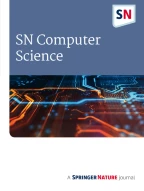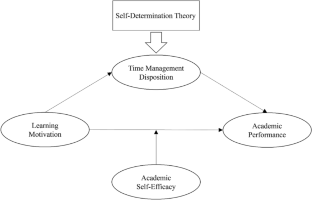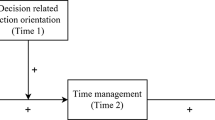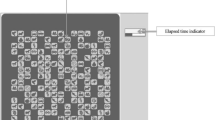Time Management Disposition in Learning Motivation and Academic Performance of Lacquer Art Majors in Fujian, China

This paper explores the effect of time management disposition on learning motive and achievement. The objective is to solve students’ widespread issue of inadequate time management skills. A comprehensive literature review informs the research, and a solid conceptual framework has been established to examine the interrelated structures. This study explored the intermediate role of time-managing disposition about study motive and achievement. Time management disposition is assumed to have a significantly positive relationship with learning motivation and academic achievement. Those who manage their time well are likelier to do well in their studies. This disposition mediates the positive effect of learning motivation on academic achievement. This study adds to the current body of knowledge by providing insight into the complex interaction of learning motives, time management patterns, and academic achievements. Recognizing the importance of fostering practical time management skills alongside enhancing motivation is crucial for educational institutions and policymakers aiming to improve student success. The results are meaningful for teachers and students, stressing that developing incentives and time-management skills is vital to optimize their learning outcomes.
This is a preview of subscription content, log in via an institution to check access.
Access this article
Subscribe and save
Springer+ Basic
€32.70 /Month
- Get 10 units per month
- Download Article/Chapter or eBook
- 1 Unit = 1 Article or 1 Chapter
- Cancel anytime
Buy Now
Price includes VAT (France)
Instant access to the full article PDF.
Rent this article via DeepDyve



Similar content being viewed by others

Willing, able, and engaged: roles of action-state orientation, intrinsic academic motivation, and time management on academic engagement
Article Open access 24 January 2024

College Students’ Time Management: a Self-Regulated Learning Perspective
Article 27 October 2020

Are Mastery-Oriented College Students Better Time Managers?
Article Open access 18 August 2021
Explore related subjects
Data Availability
All data generated or analyzed during this study are included in the manuscript.
Code Availability
References
- Adams RV, Blair E. Impact of time management behaviors on undergraduate engineering students’ performance. SAGE Open. 2019;9(1): 2158244018824506. ArticleGoogle Scholar
- Agger CA, Koenka AC. Does attending a deeper learning school promote student motivation, engagement, perseverance, and achievement? Psychol Sch. 2020;57(4):627–45. ArticleGoogle Scholar
- Ahmad Uzir NA, Gašević D, Matcha W, Jovanović J, Pardo A. Analytics of time management strategies in a flipped classroom. J Comput Assist Learn. 2020;36(1):70–88. ArticleGoogle Scholar
- Alhadabi A, Karpinski AC. Grit, self-efficacy, achievement orientation goals, and academic performance in University students. Int J Adolesc Youth. 2020;25(1):519–35. ArticleGoogle Scholar
- Ali J, Shan G, Gul N, Roh BH. An intelligent blockchain-based secure link failure recovery framework for software-defined internet-of-things. J Grid Comput. 2023;21(4):57. ArticleGoogle Scholar
- Ali J, Jhaveri RH, Alswailim M, Roh B-H. ESCALB: An effective slave controller allocation-based load balancing scheme for multi-domain SDN-enabled-IoT networks. J King Saud Univ Comput Inf Sci. 2023;35(6): 101566. Google Scholar
- Alzaanin E. Uncovering university teachers’ perspectives: conceptualizations, factors, and perceptions of second language learner engagement. Qualitative Report. 2023;28(8).
- Annett M, Grossman T, Wigdor D, Fitzmaurice G. Exploring and understanding the role of workshop environments in personal fabrication processes. ACM Trans Comput Hum Interact (TOCHI). 2019;26(2):1–43. ArticleGoogle Scholar
- Baker R, Evans B, Li Q, Cung B. Does inducing students to schedule lecture watching in online classes improve their academic performance? An experimental analysis of a time management intervention. Res High Educ. 2019;60:521–52. ArticleGoogle Scholar
- Bandura A. Self-efficacy: toward a unifying theory of behavioral change. Psychol Rev. 1977;84(2):191. ArticleGoogle Scholar
- Bhati K, Sethy T. Self-efficacy: theory to educational practice. Int J Indian Psychol. 2022;10(1):1123–8. Google Scholar
- Borkowski JG, Thorpe PK. Self-regulation and motivation: a life-span perspective on under achievement. In: Self-regulation of learning and performance. London: Routledge; 2023. p. 45–73. Google Scholar
- Bylieva D, Hong JC, Lobatyuk V, Nam T. Self-regulation in e-learning environment. Educ Sci. 2021;11(12):785. ArticleGoogle Scholar
- Camacho-Morles J, Slemp GR, Pekrun R, Loderer K, Hou H, Oades LG. Activity achievement emotions and academic performance: a meta-analysis. Educ Psychol Rev. 2021;33(3):1051–95. ArticleGoogle Scholar
- Zhang C, Roh B, Shan G. Poster: Dynamic clustered federated framework for multi-domain network anomaly detection. In: Companion of the 19th International Conference on emerging Networking EXperiments and Technologies (CoNEXT 2023). New York: Association for Computing Machinery; 2023. p. 71–2. https://doi.org/10.1145/3624354.3630086. ChapterGoogle Scholar
- DeLamater KL. Artistic practice and the craft of collaboration. Iowa: The University of Iowa; 2020. BookGoogle Scholar
- Eberle J, Hobrecht J. The lonely struggle with autonomy: a case study of first-year university students’ experiences during emergency online teaching. Comput Hum Behav. 2021;121: 106804. ArticleGoogle Scholar
- Eslit ER. Reshaping the canvas: post-pandemic strategic plan for higher education institution (2023).
- Fan KK, Li XH. Taking lacquer as a mirror, expressing morality via implements: a study of Confucian ritual spirituality and the concept of consumption in the Ming and Qing dynasties. Religions. 2020;11(9):447. ArticleGoogle Scholar
- Fan KK, Li XH, Lu MJ. A study on lacquer design teaching via digital platform. EURASIA J Math Sci Technol Educ. 2018;14(6):2203–11. Google Scholar
- Fan KK, Li XH, Lu MJ. Sustainability research on promoting the inheritance of lacquer art based on the e-learning mode—case study of the popularization of lacquer art education in primary schools in Guangzhou area. Sustainability. 2020;12(6):2195. ArticleGoogle Scholar
- Farrell O, Brunton J. A balancing act: a window into online student engagement experiences. Int J Educ Technol High Educ. 2020;17(1):1–19. ArticleGoogle Scholar
- Guo Q. Minimizing emotional labor through artificial intelligence for effective labor management of English teachers. J Combin Math Combin Comput. 2020;117:37–46. ArticleGoogle Scholar
- Hassan H, Hariri NA, Khan K. Enhancing intrinsic motivation to learn in adults: empowering ESL students. Int J Engl Linguist. 2020;10(1):81–90. ArticleGoogle Scholar
- Howard JL, Bureau JS, Guay F, Chong JX, Ryan RM. Student motivation and associated outcomes: a meta-analysis from self-determination theory. Perspect Psychol Sci. 2021;16(6):1300–23. ArticleGoogle Scholar
- Hung CS, Chen TL, Lee YC. From cultural heritage preservation to art craft education: a study on Taiwan traditional lacquerware art preservation and training. Educ Sci. 2021;11(12):801. ArticleGoogle Scholar
- Islam R, Ali MY, Osmani NM. Time management for better job performance: an analysis from Al-Wasatiyyah perspective. Asian Acad Manag J. 2021;26:171–96. ArticleGoogle Scholar
- Jayme SM, Aparecio M, Bendanillo AA, Arana AMM, Dumdum JP, Ikeshiro N, Toring K. Time management on task completion of science, technology, engineering, and mathematics (STEM) students of ECT Excellencia Global Academy Foundation, Inc. Sci Educ. 2023;4(2):1160–70. Google Scholar
- Zhou J, Li B, Zhang D, Yuan J, Zhang W, Cai Z. UGIF-Net: an efficient fully guided information flow network for underwater image enhancement. IEEE Trans Geosci Remote Sens. 2023;61:1–17. https://doi.org/10.1109/TGRS.2023.3293912. ArticleGoogle Scholar
- Zhou J, Zhang D, Zhang W. Cross-view enhancement network for underwater images. Eng Appl Artif Intell. 2023;121: 105952. ArticleGoogle Scholar
- Zhou J, Liu Q, Jiang Q, Ren W, Lam K-M, Zhang W. Underwater image restoration via adaptive dark pixel prior and color correction. Int J Comput Vis. 2023. https://doi.org/10.1007/s11263-023-01853-3. ArticleGoogle Scholar
- Karlen Y, Suter F, Hirt C, Merki KM. The role of implicit theories in students’ grit, achievement goals, intrinsic and extrinsic motivation, and achievement in the context of a long-term challenging task. Learn Individ Differ. 2019;74: 101757. ArticleGoogle Scholar
- Kocak O, Goksu I, Goktas Y. The factors affecting academic achievement: a systematic review of meta analyses. Int Online J Educ Teach. 2021;8(1):454–84. Google Scholar
- Kosikova M, Loumova V, Kovalova J, Vasanicova P, Bondarenko VM. A cross-culture study of academic procrastination and using effective time management. Period Polytech Soc Manag Sci. 2020;28(2):121–8. ArticleGoogle Scholar
- Krskova H, Breyer Y, Baumann C, Wood LN. An exploration of university student perceptions of discipline: introducing FIRST discipline principles. High Educ Skills Work-Based Learn. 2020;10(1):61–82. ArticleGoogle Scholar
- Li J, Lin Y. Teaching thoughts and cases analysis of the innovative design of lacquer art products in the multi-disciplinary and trans-boundary historical background. In: Cross-cultural design. applications in cultural heritage, creativity and social development: 10th international conference, CCD 2018, held as part of HCI International 2018, Las Vegas, NV, USA, July 15–20, 2018, Proceedings, Part II 10. Cham: Springer International Publishing; 2018. p. 186–95. ChapterGoogle Scholar
- Li J, Xue E. The quest for sustainable graduate education development: narrative inquiry of early doctoral students in China’s world-class disciplines. Sustainability. 2022;14(18):11564. ArticleGoogle Scholar
- Liang J. Let the excellent Chinese traditional culture pass on from generation to generation in colleges and universities. Educ Rev USA. 2022;6(12):832–6. ArticleGoogle Scholar
- Liang X, Cheng W, Zhang C, Wang L, Yan X, Chen Q. YOLOD: a task decoupled network based on YOLOv5. IEEE Trans Consum Electron. 2023;69:775–85. ArticleGoogle Scholar
- Lopes AR, Nihei OK. Depression, anxiety and stress symptoms in Brazilian university students during the COVID-19 pandemic: predictors and association with life satisfaction, psychological well-being and coping strategies. PLoS One. 2021;16(10): e0258493. ArticleGoogle Scholar
- Luo X, Zhang C, Bai L. A fixed clustering protocol based on random relay strategy for EHWSN. Digit Commun Netw. 2023;9(1):90–100. ArticleGoogle Scholar
- Martínez IM, Youssef-Morgan CM, Chambel MJ, Marques-Pinto A. Antecedents of academic performance of university students: academic engagement and psychological capital resources. Educ Psychol. 2019;39(8):1047–67. ArticleGoogle Scholar
- Moghadari-Koosha M, Moghadasi-Amiri M, Cheraghi F, Mozafari H, Imani B, Zandieh M. Self-efficacy, self-regulated learning, and motivation as factors influencing academic achievement among paramedical students: a correlation study. J Allied Health. 2020;49(3):145E-152E. Google Scholar
- Morris LS, Grehl MM, Rutter SB, Mehta M, Westwater ML. On what motivates us: a detailed review of intrinsic v. extrinsic motivation. Psychol Med. 2022;52:1801–16. ArticleGoogle Scholar
- Nazeer S, Sultana N, Bonyah E. Cycles and paths related vertex-equitable graphs. J Combin Math Combin Comput. 2023;117:15–24. ArticleMathSciNetGoogle Scholar
- Okano K, Kaczmarzyk JR, Dave N, Gabrieli JD, Grossman JC. Sleep quality, duration, and consistency are associated with better academic performance in college students. NPJ Sci Learn. 2019;4(1):16. ArticleGoogle Scholar
- Pollack B. Brand new art from China: a generation on the rise. Berlin: Bloomsbury Publishing; 2018. BookGoogle Scholar
- Rahiem MD. Remaining motivated despite the limitations: university students’ learning propensity during the COVID-19 pandemic. Child Youth Serv Rev. 2021;120: 105802. ArticleGoogle Scholar
- Rahimi AR, Cheraghi Z. Unifying EFL learners’ online self-regulation and online motivational self-system in MOOCs: a structural equation modeling approach. J Comput Educ. 2022;11:1–27. ArticleGoogle Scholar
- Ramzan M, Javaid ZK, Fatima M. Empowering ESL students: harnessing the potential of social media to enhance academic motivation in higher education. Glob Digit Print Media Rev. 2023;VI:224–37. ArticleGoogle Scholar
- Ren X, Ahmed I, Liu R. Study of topological behavior of some computer related graphs. J Combin Math Combin Comput. 2023;117:3–14. ArticleMathSciNetGoogle Scholar
- Rivers DJ. The role of personality traits and online academic self-efficacy in acceptance, actual use and achievement in Moodle. Educ Inf Technol. 2021;26(4):4353–78. ArticleGoogle Scholar
- Rodriguez S, Núñez JC, Valle A, Freire C, Ferradás MDM, Rodriguez-Llorente C. Relationship between students’ prior academic achievement and homework behavioral engagement: the mediating/moderating role of learning motivation. Front Psychol. 2019;10:1047. ArticleGoogle Scholar
- Ryan RM, Deci EL. Intrinsic and extrinsic motivation from a self-determination theory perspective: definitions, theory, practices, and future directions. Contemp Educ Psychol. 2020;61: 101860. ArticleGoogle Scholar
- Ryan RM, Deci EL. Self-determination theory. In: Encyclopedia of quality of life and well-being research. Cham: Springer International Publishing; 2022. p. 1–7. Google Scholar
- Ryan RM, Deci EL, Vansteenkiste M, Soenens B. Building a science of motivated persons: SElf-determination theory’s empirical approach to human experience and the regulation of behavior. Motiv Sci. 2021;7(2):97. ArticleGoogle Scholar
- Schunk DH, DiBenedetto MK. Self-efficacy and human motivation. In: Advances in motivation science, vol. 8. Amsterdam: Elsevier; 2021. p. 153–79. Google Scholar
- Seli H. Motivation and learning strategies for college success: a focus on self-regulated learning. London: Routledge; 2019. BookGoogle Scholar
- Song X, Yang Y, Yang R, Shafi M. Keeping watch on intangible cultural heritage: live transmission and sustainable development of Chinese lacquer art. Sustainability. 2019;11(14):3868. ArticleGoogle Scholar
- Sun Y, Liao CC, Chang SC, Lin R. The Communication mechanism in the workshop and its implications for the sustainable development of traditional crafts: a case study of lacquer culture in Taomi eco-village. Sustainability. 2022;14(21):13813. ArticleGoogle Scholar
- Tokan MK, Imakulata MM. The effect of motivation and learning behaviour on student achievement. South Afr J Educ. 2019. https://doi.org/10.15700/saje.v39n1a1510. ArticleGoogle Scholar
- Trautner M, Schwinger M. Integrating the concepts self-efficacy and motivation regulation: how do self-efficacy beliefs for motivation regulation influence self-regulatory success? Learn Individ Differ. 2020;80: 101890. ArticleGoogle Scholar
- Trentepohl S, Waldeyer J, Fleischer J, Roelle J, Leutner D, Wirth J. How did it get so late so soon? The effects of time management knowledge and practice on students’ time management skills and academic performance. Sustainability. 2022;14(9):5097. ArticleGoogle Scholar
- Wang X, Liu J, Zhang C. Network intrusion detection based on multi-domain data and ensemble-bidirectional LSTM. EURASIP J Inf Secur. 2023;2023(1):5. ArticleGoogle Scholar
- Wolters CA, Brady AC. College students’ time management: a self-regulated learning perspective. Educ Psychol Rev. 2020;33:1319–51. ArticleGoogle Scholar
- Wong IH, Wong TT. Exploring the relationship between intellectual humility and academic performance among post-secondary students: the mediating roles of learning motivation and receptivity to feedback. Learn Individ Differ. 2021;88: 102012. ArticleGoogle Scholar
- Wood M. The story of China: a portrait of a civilisation and its people. New York: Simon and Schuster; 2020. Google Scholar
- Xu F, Wu T, Huang S, Han K, Lin W, Wu S, Dinesh Jackson SR. Extensive classification of visual art paintings for enhancing education system using hybrid SVM-ANN with sparse metric learning based on kernel regression. Int J Interact Multimed Artif Intell. 2021. https://doi.org/10.9781/ijimai.2021.10.001. ArticleGoogle Scholar
- Yang H, Anbarasan M, Vadivel T. Knowledge-based recommender system using artificial intelligence for smart education. J Interconnect Netw. 2022;22(Supp02):2143031. ArticleGoogle Scholar
- Yang N, Zang X, Chen C. Inheritance patterns under cultural ecology theory for the sustainable development of traditional handicrafts. Sustainability. 2022;14(22):14719. ArticleGoogle Scholar
- Ye Z, Jiao X. Contemporary art on realistic subjects in the new era of lacquer painting. Asian J Soc Sci Stud. 2022;7(7):75. ArticleGoogle Scholar
- Zeng Y, Chu B. The appropriate scale of competition between online taxis and taxis based on the Lotka–Volterra evolutionary model. J Combin Math Combin Comput. 2024;117:25–36. ArticleMathSciNetGoogle Scholar
Funding
No funds or grants were received by any of the authors.







